The Church, North Portland, and Me, the Atheist
by Steve, April 14th, 2007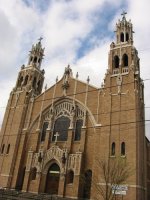 The Catholic Archdiocese of Portland dodged a major bullet yesterday, when a federal bankruptcy judge ruled that they don’t have to sell any properties to settle child sex abuse cases. In an answer to their prayers, they get to transfer church and school properties to the parishes. This is exactly what the gambled on when, in 2004, they were the first archdiocese in the US to file for bankruptcy protection in the face of hundreds of millions of dollars in sex abuse lawsuits.
The Catholic Archdiocese of Portland dodged a major bullet yesterday, when a federal bankruptcy judge ruled that they don’t have to sell any properties to settle child sex abuse cases. In an answer to their prayers, they get to transfer church and school properties to the parishes. This is exactly what the gambled on when, in 2004, they were the first archdiocese in the US to file for bankruptcy protection in the face of hundreds of millions of dollars in sex abuse lawsuits.
Wacky Mommy took one look at the picture in the paper of St. Andrew’s Church in Northeast Portland and said “I wish they’d make them sell off their churches, and then they’d have to open up store-front churches like all the other churches in North Portland.” You know, like “Christ Died For Your Sins on the Bloody Cross of Holy Redemption Church of God in Christ our Lord.” But seriously, the Catholic Church’s holdings, including St. Andrew’s (pictured above) are quite ostentatious compared to the rest of the churches in the neighborhood. Would it kill them to cough up a little more to atone for protecting child sex abusers for so long?
North and Northeast Portland are home to the only historically black neighborhoods in Portland. Store-front churches abound, but with gentrification pushing in (and Portland Community College’s Cascade campus expanding), they may soon be an endangered species. So while Wacky Mommy took the Wacky Kids to swim lessons this morning, I took a brief tour of North and Northeast Portland churches.
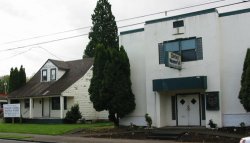 First stop was the Christ Memorial Church of God in Christ, with its adjacent “Future Home of Community Center & Basketball Pavilion.”
First stop was the Christ Memorial Church of God in Christ, with its adjacent “Future Home of Community Center & Basketball Pavilion.”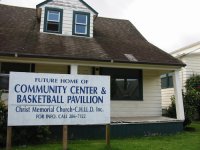
Next comes what we refer to as the “LoveLee Ladee” complex, which includes both the Holiness or Hell Church of God in Christ and the Jubilee Tabernacle Full Gospel, Pentacostal Church.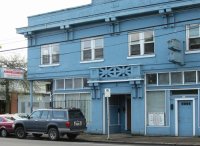 We refer to it as “LoveLee Ladee” because of the painted-over sign above the entrance to Holiness or Hell, indicating it used to house a beauty salon, or, uh, well, you know.
We refer to it as “LoveLee Ladee” because of the painted-over sign above the entrance to Holiness or Hell, indicating it used to house a beauty salon, or, uh, well, you know.
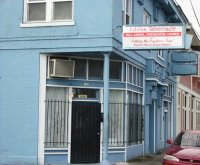 The entire complex used to be Holiness or Hell, but at some point the Jubilee Tabernacle came in.
The entire complex used to be Holiness or Hell, but at some point the Jubilee Tabernacle came in.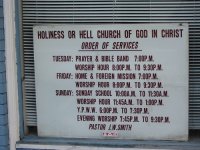
Across the street from LoveLee Ladee is the Full Holy Ghost Mission Church of God in Christ, Inc., fronted by a lot of blacktop and a forbidding chain-link fence.
A block further, we get a threefer: A More Excellent Way Christian Center, Northwest Voice for Christ Community Church, and The Ark of Safety Church of God Pentacostal, all housed in a building with a facade made to look like Noah’s Ark.
Just a few blocks over, we come upon the Open Door House of Prayer.
I’m not posting pictures here to make fun of these joints. Even though I am a dyed-in-the-wool atheist, I respect the right of people to worship (or not) as they choose. And I am impressed by the humility of these neighborhood based churches, many of them unaffiliated with larger governing bodies. They stand in sharp contrast to the Catholic church, one of the wealthiest and most powerful organizations on the planet. And every Sunday finds them brimming over with lively music and sharply dressed parishioners (oh the hats!).
The gentrification I mentioned before recently claimed the only black funeral home in town, and turned it into a pub. I’m not shitting you. Across the street from that is the Florida Room, a hipster restaurant whose reader board proclaims it as the Church of the Bloody Mary and for a long time also sported the message “Go Team Evil! Sin all the Damn Time!” This is just a stone’s throw from the LoveLee Ladee. Of course, as an atheist, I have no problem with this personally, but it is culturally insensitive (to say the least).
In ten years, there will probably be no more store-front churches in this neighborhood. The part of me that sees religious belief as the source of global strife doesn’t care. But the part of that appreciates diversity and humility is saddened.






April 18th, 2007 at 12:21 pm
wow – very thought-provoking (or just provoking?) entry. I had no idea the Chapel was another victim to lost ethnicity and history in the area. Sad, especially since we felt like the forgotten dead the time we ate there.
“Gentrification” is tossed around a lot in these parts – local articles, preaching, etc… often without solutions or hope. Any ideas?
April 18th, 2007 at 1:53 pm
Gentrification can only be dealt with in terms of urban planning and regulation. For instance, when there is an urban renewal district that changes zoning and displaces low-income housing, what measures are taken to compensate?
Here’s one small example:
In the case of the Interstate Corridor Urban Renewal Area (ICURA), New Seasons got a variance that reduced low- and moderate-income housing opportunities in the neighborhood. As zoned and envisioned by planners, that corner lot at Rosa Parks and Interstate should have been street level retail with parking beneath and 20-some units of affordable housing above (much like the very workable design of Whole Foods in the Pearl).
The owners of New Seasons didn’t want to make that investment in the neighborhood, so they cut a back-room deal that allowed them to transfer the low-income housing units to a project in outer Southeast Portland and build a surface parking lot adjacent to a transit stop.
New Seasons presented this as a “take it or leave it” proposition, and city planners (and the local neighborhood associations) “took it” for fear that New Seasons wouldn’t build if they had to invest enough to fit their development to the vision of high density, transit-oriented architecture.
Maintaining that their customers “don’t take mass transit to do their shopping,” they set the store as far back from the transit stop on their lot as possible, built a parking lot at what was envisioned as a pedestrian-friendly intersection, and displaced 20-odd planned affordable housing units. The net result (besides the displaced housing) is that both the parking lot and store are too small, and the vision of walkable neighborhoods with street level businesses clustered around transit stops is subverted by suburban style, car-oriented architecture.
Not only does it displace working people; it’s ugly and moderately dysfunctional (cramped parking and over-crowded retail space with inadequate shelf and storage space).
There is such a thing as urban renewal without massive displacement. Unfortunately, the Portland Development Commission, the City of Portland, and the local neighborhood associations are either too intimidated or too cowed by business interests to stand up for the working poor, who are increasingly being pushed to the outer east side.
Development and affordable housing are not mutually exclusive; business owners just act that way. And our governing bodies have a tendency to let them get away with it, by way of issuing zoning variances. This is why the black community of Portland gets nervous whenever the PDC starts talking about another urban renewal project.
April 24th, 2007 at 9:00 am
okay, I seem to walk myself into these discussions knowing that it is going to fan a flame, but here goes (in the best spirit possible)…
“Gentrification can only be dealt with in terms of urban planning and regulation.”
I respectfully disagree in part . Absolutely, these are key parts of dealing with it, and frankly I think PDX does a better job than many cities in the world (not that it’s fantastic).
However, another (maybe more important) piece is helping generationally-impoverished people groups, regions, and neighborhoods improve. People – not just in the US – have done a very poor job of promoting prosperity, innovation, and growth in the midst of valuing culture and history. The result seems to have one of two attitudes: 1) “either change with us and follow our ideas, or we’ll abandon you” or 2) “we want nothing to do with your fancy green coffee shops; leave us to ourselves.”
The tragic result is more segregation, more fear, and a deeply widening gap between races and economic strata. Generations grow up, and we see a common trebd: they get educated and return to their old neighborhoods (or into new ones), hoping to improve the situation they see. They’re faced with racism or fear – often hearing “get your new-fandangled ideas out of here!”
The other option is they stay put, follow in the failing footsteps of those who are dying, and the cycle intensifies.
It shouldn’t be either/or; how about both/and?! We need to be willing to really hear people’s concerns (even if we disagree with what we hear) and open to compromising for the good of our whole community and future generations.
Real cooperative action by real people – existing and new in a community – will do a lot more than laws or codes.
April 26th, 2007 at 11:42 am
mamatoo,
i think you raise some good points. i think good planning linked to economic policies that promote justice is the best way to deal with the downsides of gentrification.
the conditions extant in north portland in the 90’s were the result of economic policies that intentionally impoverished the area. now that money is pouring into the neighborhood, the communities here are faced with some terrible choices.
not that i have any good solutions… but i see my neighbors look at the value of their homes, worth 10x what they were worth only 5 years ago, and struggle with the choices. should they sell out? lots of them want to sell to people in the community- but those people arent buying!
another point i want to make is that change is a constant with cities. the chapel of the chimes was not originally an african american business. the storefront churches were originally stores. the trick is not to prevent change, but to make sure that the winners are those who deserve to win, and the losers are those who deserve to lose.
April 26th, 2007 at 12:57 pm
george wrote: “the trick is not to prevent change, but to make sure that the winners are those who deserve to win, and the losers are those who deserve to lose.”
That’s a neat trick, George! :)
If you figure it out, make sure you share with the rest of us.
April 26th, 2007 at 3:56 pm
yes, george, I like the concept of fixing the “outcome,” but how do we do that? And if we’re new to the neighborhood, how do we honor the history while supporting good change?
himself – write more. you’re a good history teacher of NoPo reality.